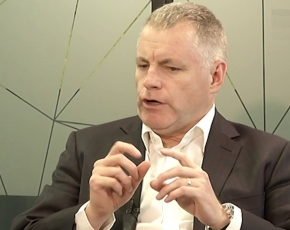
Sappi Announces Financial Results for Fiscal 2019 Fourth Quarter and Full Year "An initially strong start to the year was unfortunately offset by weak graphic paper markets and lower dissolving wood pulp prices driven by the ongoing trade wars and slower economic growth in various geographies." – Steve Binnie, CEO, Sappi Limited.
"An initially strong start to the year was unfortunately offset by weak graphic paper markets and lower dissolving wood pulp prices driven by the ongoing trade wars and slower economic growth in various geographies." – Steve Binnie, CEO, Sappi Limited.
Nov. 14, 2019 (Press Release) - Commenting on the results, Sappi Chief Executive Officer Steve Binnie said: "An initially strong start to the year was unfortunately offset by weak graphic paper markets and lower dissolving wood pulp prices driven by the ongoing trade wars and slower economic growth in various geographies. Our EBITDA declined by 10% year-on-year due to lower dissolving wood pulp prices and weak graphic paper demand. Our strategy to diversify our product portfolio into higher margin segments continues to deliver positive results." "The trend towards paper-based packaging in consumer segments continues, and we experienced stable demand for containerboard in the South African market. The recent projects to increase capacity at each of the DWP mills and convert capacity at Somerset and Maastricht towards packaging boosted sales volumes in each of these segments during the year, and for the quarter delivered improved margins, thereby lessening the impact of weak graphic paper markets." Reflecting on the 4th quarter, Binnie indicated: "I am pleased that we were able to generate cash of US$173 million in the quarter thereby ending the year with net debt at US$1,501 million. This was done by tightly managing working capital and postponing discretionary capital expenditure." Looking forward, Binnie stated: "Due to the current very weak pricing in the DWP market and with paper markets yet to show signs of a sustained recovery in demand, we expect EBITDA in the first quarter of financial year 2020 to be below that of 2019. Management have taken a number of steps to mitigate the effect that the current uncertain market conditions and low DWP prices are having on the profitability and leverage of the group. These steps include tighter working capital management, the postponement and reduction in capital expenditure. The directors have furthermore concurred with management that it would be prudent to temporarily halt dividends until such time as market conditions improve." Financial summary for the quarter and full year
The major factors which influenced the group's results include:
In particular for the quarter:
OutlookThe markets we operate in are expected to continue to be challenging in the coming year, and profitability is likely to be negatively impacted as a result. DWP pricing in particular will have a significant impact on earnings as this segment is a major contributor to our profits and cash flow generation. We have responded by reducing our capital expenditure both this past year and the next, and other than the 110,000t expansion of Saiccor which is currently underway we have not committed capital to any material project. We have reduced working capital, amended debt covenants, targeted further cost reductions and are evaluating various options regarding our paper machines in Europe in order to lower fixed costs and match capacity to demand. DWP pricing remains under significant pressure, having declined to historic lows of US$638/ton at the time of writing this report, US$306/ton below that of a year ago. We believe that current pricing is below the cash cost of production for a significant proportion of global supply and is therefore unsustainable over any prolonged period. Underlying demand for DWP is still growing at rates consistent with our long-term forecasts. A recovery in DWP prices is likely to be prompted by a recovery in VSF prices which have been depressed by excess VSF capacity and a weak Chinese textile market. In the packaging and speciality segment we are making good progress with customer acceptance in both the US and European markets and the ramp-up of volumes continues, aided by the shift from plastic to paper in many packaging categories. However, the slowing South African economy will likely impact domestic demand for containerboard in the coming year. Global graphic paper markets continue to experience weakness due to a combination of economic factors as well as the ongoing shift towards digital media. Pricing has declined only marginally over the past quarter, and as paper pulp prices in Europe and North America approach those prevalent in China, margins should be maintained. Capital expenditure in 2020 is expected to decrease to US$460 million as we complete the Saiccor 110kt expansion project and some smaller European pulp mill debottlenecking projects. The payment of the adjusted Matane net acquisition price of approximately US$158m will be made in the first quarter of the financial year, funded via a new term loan. About Sappi LimitedHeadquartered in Johannesburg, South Africa, Sappi is a global leader in paper, paper pulp and dissolving wood pulp solutions. The company has over 12,000 employees; manufacturing operations on three continents, in seven countries (nine mills in Europe, three mills in America and four mills in South Africa) and customers in over 150 countries worldwide. In FY2018 Sappi produced approximately: 5.7 million tons of printing and writing, speciality and packaging paper; 2.3 million tons of paper pulp, and 1.4 million tons of dissolving wood pulp. The company continues to invest in developing biomaterials (nanocellulose, fibre composites and lignosulphonate) and biorefinery (second generation sugars and bio-energy) businesses. To learn more, visit: www.sappi.com. SOURCE: Sappi Limited |